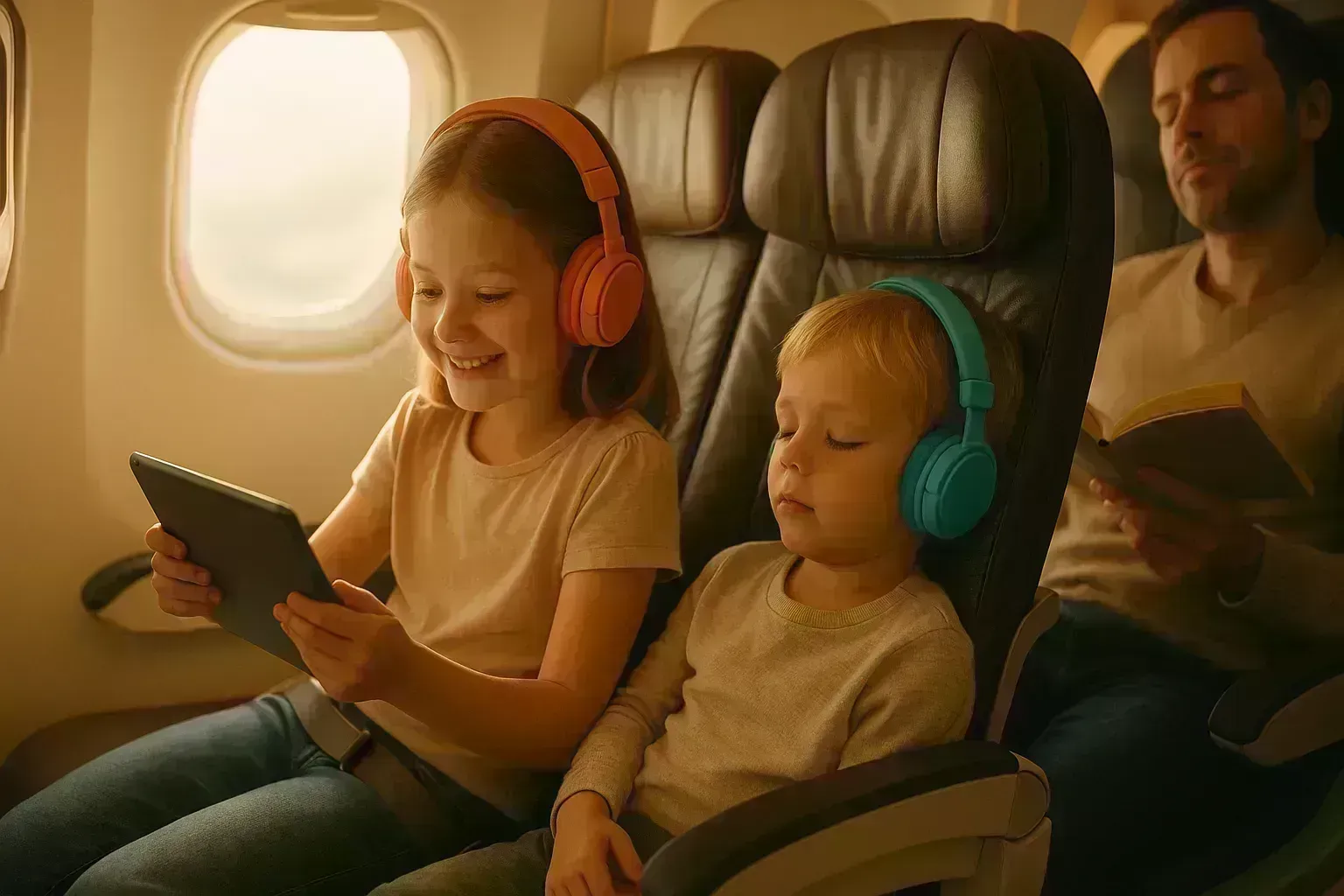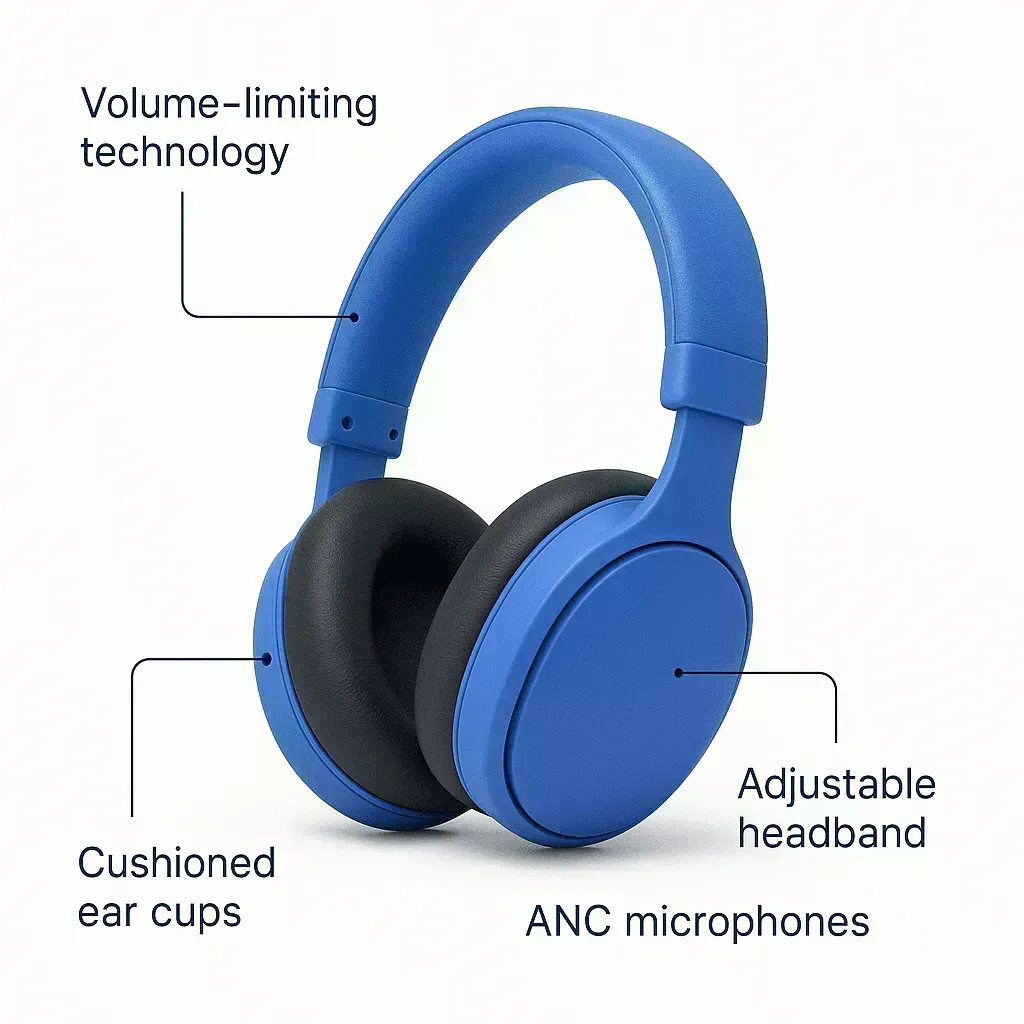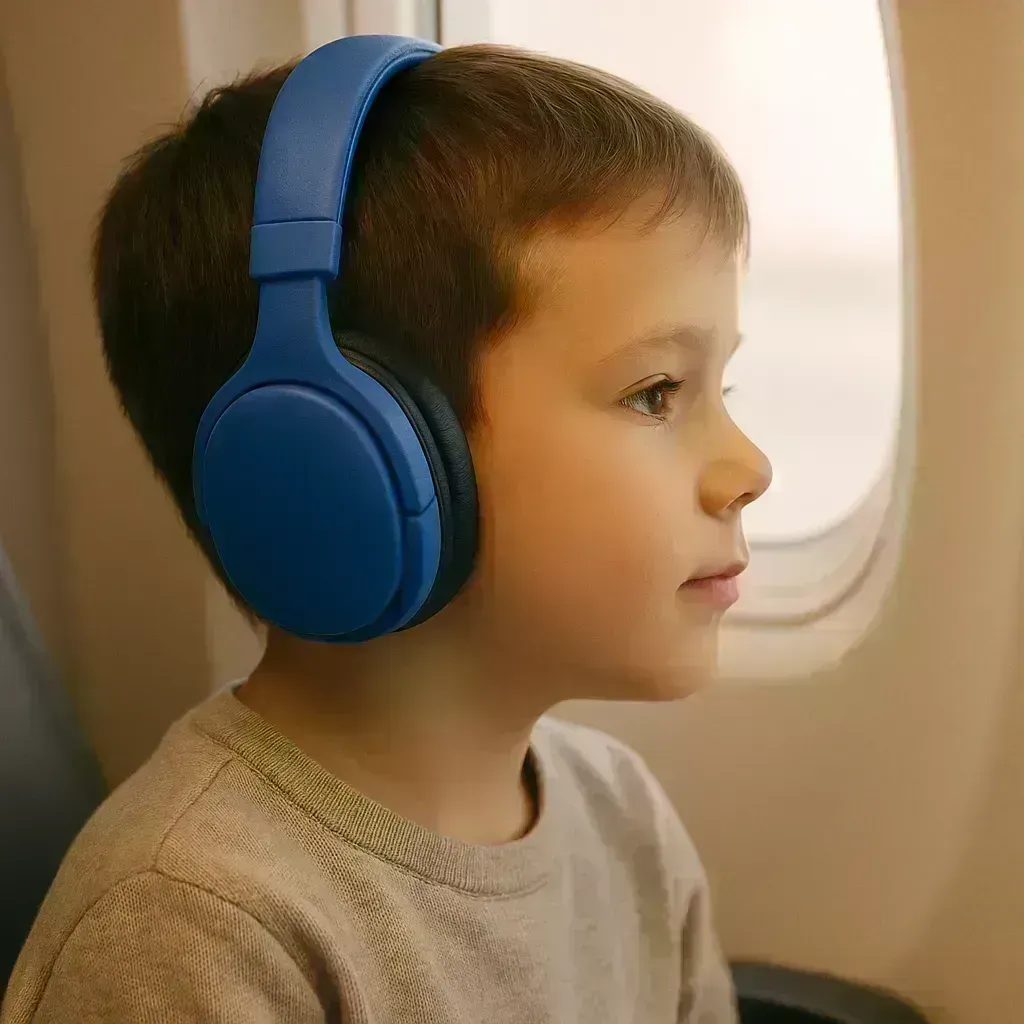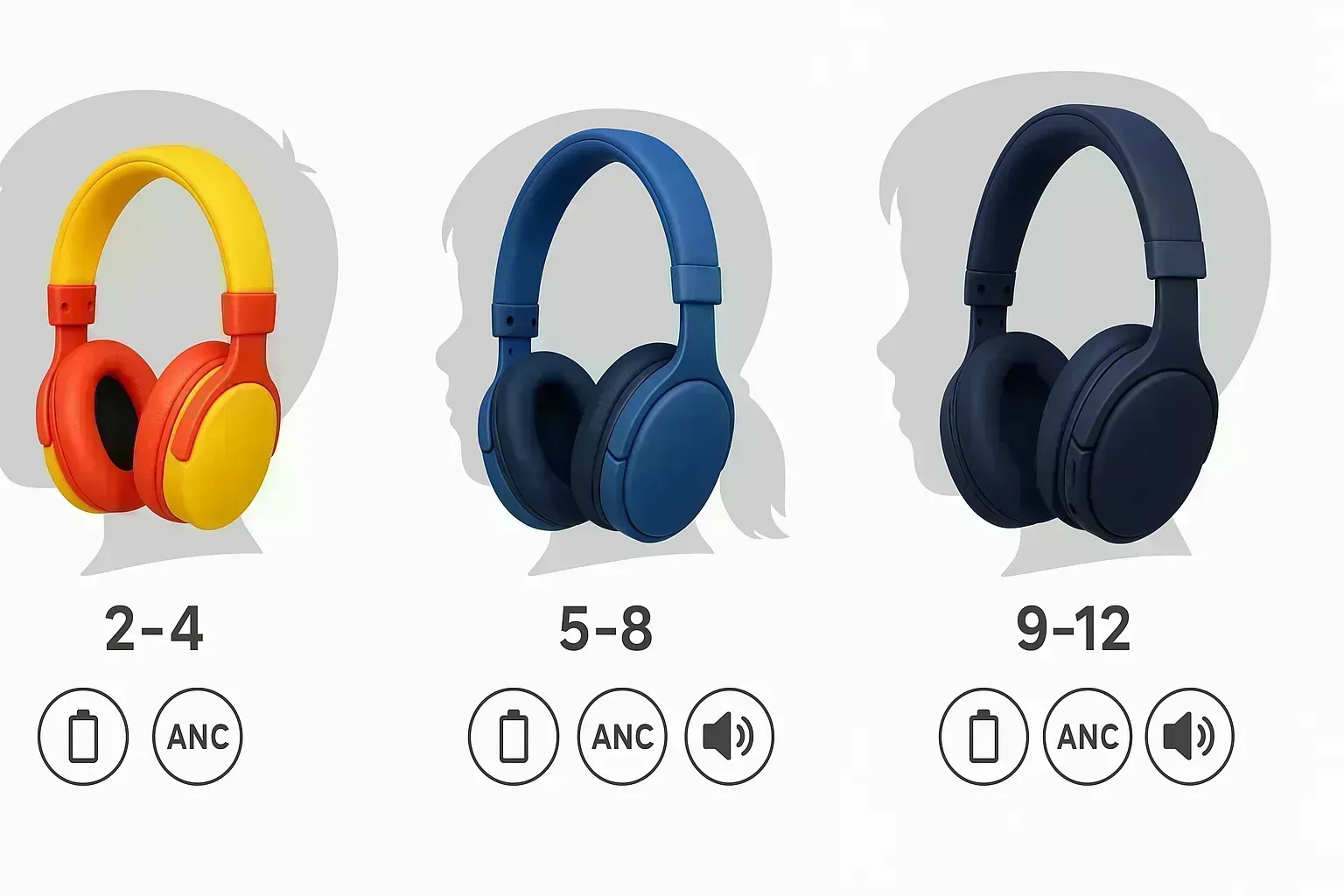
This blog post may contain affiliate links that help us maintain the website. We may earn a small commission when you make a purchase through these links at no additional cost to you.
Noise-Cancelling Headphones for Kids: The Complete Buying Guide for Travel (2025)
Last week on our flight to Disney World, I glanced over to see my 7-year-old daughter completely absorbed in her audiobook, undisturbed by the roaring engines and crying baby three rows back. Meanwhile, my 4-year-old son slept peacefully with his own pair of pint-sized noise-cancelling headphones. That moment of tranquility wasn't luck—it was the result of carefully choosing the right headphones for each of my kids.
Regular adult headphones aren't just uncomfortable for children; they can actually damage young ears. Kids' hearing is more sensitive than adults', and without proper volume limiting, even short listening sessions can cause long-term hearing problems. Add in the extra noise from travel environments like airplanes or busy train stations, and children tend to crank up the volume to potentially harmful levels.
That's where specialized noise-cancelling headphones for kids come in. These aren't just smaller versions of adult models—they're specifically engineered with child hearing safety in mind, while still delivering the immersive experience kids want for their games, movies, and music during travel.
In this comprehensive guide, I'll walk you through everything you need to know about selecting the perfect noise-cancelling headphones for your traveling children—from critical safety features and comfort considerations to my top recommendations for every budget and age group in 2025.
Why Kids Need Special Noise-Cancelling Headphones for Travel
Children's ears are fundamentally different from adults'. Their ear canals are smaller, making them more susceptible to damage from loud noises. What's merely uncomfortable for us can be potentially harmful for them. This sensitivity is why specialized headphones for kids aren't just a convenience—they're a necessity.
The gold standard for children's headphones is volume limiting technology that caps sound at 85 decibels, which is the maximum recommended safe listening level established by audiology experts and organizations like the World Health Organization. Regular headphones can often reach 100-110 decibels, levels that can damage young ears in just 15 minutes of exposure.
But volume limiting alone isn't enough for travel scenarios. That's where noise-cancellation becomes crucial. Here's the key difference: volume-limiting only restricts how loud the headphones can play, while noise-cancellation actually reduces external noise. Without noise-cancellation, kids often turn up volume to overcome ambient noise like jet engines or highway sounds, potentially pushing against those volume limits.
The travel environment presents unique audio challenges. Aircraft cabins typically generate 80-85 dB of ambient noise—right at the threshold of safe listening levels before adding any media playback. By actively reducing this environmental noise, noise-cancelling headphones let kids enjoy their content at safer volumes while still being able to hear it clearly.
Beyond safety, there are developmental benefits too. The noise reduction helps children focus better on their content, reduces sensory overload in stimulating travel environments, and can significantly improve their ability to rest or sleep during journeys. My son used to struggle with napping on flights until we invested in proper noise-cancelling headphones—now he's typically asleep before we reach cruising altitude.
Essential Safety Features to Look For

When evaluating noise-cancelling headphones for your children, safety features should be your primary consideration. Volume limitation is non-negotiable, but not all limiting mechanisms are created equal.
The most reliable volume-limiting headphones have hardwired volume restrictions that physically cannot exceed 85dB, regardless of the device they're connected to. Software-based limiters are less dependable, as they can sometimes be overridden by certain devices or apps. Look for headphones that explicitly state they have "hardwired" or "always-on" volume limiting.
For noise cancellation technology, you'll encounter two main types: active and passive. Active noise cancellation (ANC) uses microphones to detect external sounds and then generates sound waves that cancel them out. Passive noise isolation simply creates a physical barrier against outside noise through padded ear cups and tight seals.
For most family travel scenarios, I recommend active noise cancellation for children over age 5. For younger children, some parents prefer passive isolation as it's simpler and has no potential for the slight pressure sensation that some kids find uncomfortable with ANC. My daughter had no issues with ANC from age 4, while my son preferred passive isolation until he was about 6.
Material safety is another crucial consideration that many parents overlook. Check that ear cushions and headbands use hypoallergenic materials, especially for children with sensitive skin or allergies. Also verify that plastics are BPA-free and non-toxic, particularly for younger children who might chew on headphone parts.
The wired versus wireless debate has safety dimensions too. Wireless Bluetooth models eliminate entanglement risks but introduce battery concerns. For children under 5, I generally recommend wired models with flat, tangle-resistant cords. For older kids, Bluetooth models offer more freedom but ensure they have automatic shut-off features to preserve battery life.
Proper fit isn't just about comfort—it directly impacts noise cancellation effectiveness and hearing protection. Headphones that don't create a good seal around or on the ears can't properly cancel noise, which often leads kids to increase volume. When testing, make sure the headphones adjust small enough for your child's head and that ear cups fully cover their ears without gaps.
Comfort and Durability Factors for Young Travelers

Even the safest headphones won't protect your child if they're too uncomfortable to wear. For family travel, comfort isn't just a nice-to-have—it's essential for those long stretches in transit when kids need entertainment the most.
The headband is where most discomfort occurs for children. Look for generous padding, especially on the underside, and materials that won't catch or pull hair. The best kids' models feature adjustable headbands with clear size indicators so you can achieve symmetrical fit. Some premium models even incorporate memory foam that contours to your child's head shape.
Weight is critically important, particularly for younger children whose neck muscles tire easily. Aim for headphones under 180 grams (about 6.3 ounces) for children under 8, and under 250 grams for older kids. Every time we upgrade my daughter's headphones, I place both options on a kitchen scale—even 30 grams can make a difference in comfort during a six-hour flight.
Ear cushion materials significantly impact both comfort and hygiene during travel. Protein leather (also called leatherette) is easier to wipe clean but can get sweaty during long use. Fabric covers breathe better but collect more dirt. My personal preference for family travel is leatherette cushions with small perforations for airflow—they clean easily with disinfectant wipes between uses.
When traveling, storage efficiency matters enormously. Foldable designs that collapse into compact carrying cases save precious backpack space and protect the headphones from damage. Look for models where the ear cups rotate flat and the headband folds in, ideally compressing to half their operational size.
Durability features should address the most common failure points in kids' headphones. Reinforced headbands with metal or high-grade plastic cores prevent snapping—the number one breakdown I've experienced with cheaper models. Detachable cables are worth their weight in gold; children inevitably yank, twist, and step on cords, and being able to replace just the cable has saved us from buying new headphones multiple times.
Some degree of water and splash resistance is valuable for family travel. While fully waterproof headphones are rare and expensive, IPX4-rated models can handle light rain and the inevitable juice spill without failing. This rating has become my minimum standard after losing two pairs of headphones to drink accidents on road trips.
Connectivity Options for Family Travel
The connectivity features you choose should align with both your destinations and your children's specific needs during travel.
Bluetooth connectivity offers wonderful freedom from cords but introduces battery life management. For kids under 8, I recommend headphones with at least 18 hours of battery life—enough for a long travel day without charging. For older kids who might use headphones more continuously, look for 25+ hours. Always check if the rated battery life applies with noise-cancellation turned on, as this feature typically reduces operating time by 20-40%.
Despite the wireless trend, wired connection options remain essential for family travel. Many airplane entertainment systems still require a 3.5mm headphone jack, so even if you choose Bluetooth headphones, ensure they include a wired option. Some newer models come with USB-C connections instead of the traditional headphone jack—these work with newer devices but may need adapters for airplane systems.
Sharing capabilities can be surprisingly important for siblings traveling together. Two approaches exist: hardware sharing via built-in splitters that allow two pairs of headphones to connect to one device, or software sharing through Bluetooth dual-connect features. My kids prefer the latter since it allows them to sit more comfortably without being tethered close together.
Parent monitoring features have evolved significantly in recent years. Several premium models now offer companion apps that let parents view volume levels in real-time and set maximum listening times. Some even include "listen-in" functions where parents can momentarily hear what their child is listening to through their own devices—particularly useful for younger children.
Age-Appropriate Recommendations for Different Travel Needs

Children's headphone needs evolve dramatically as they grow, and matching features to developmental stages improves both usage and longevity.
For toddlers (ages 2-4), simplicity and safety dominate. Look for:
- Ultra-lightweight designs under 150 grams
- Passive noise isolation rather than active cancellation
- Minimal buttons to prevent accidental operation
- Wired connections with durable, straight (not coiled) cords
- Headbands with at least 2" of adjustment range for growth
- Washable ear cushions for inevitable messes
For young children (ages 5-8), the sweet spot balances growing tech interest with appropriate protections:
- Active noise cancellation with simple on/off switches
- Introduction to wireless with straightforward Bluetooth pairing
- Longer battery life (18+ hours) as attention spans expand
- More adjustable fit as head shapes mature
- Basic on-ear controls for volume and track skipping
- Carrying cases with internal cable management
For older kids (ages 9-12), more sophisticated options align with their growing independence:
- Premium sound quality as music appreciation develops
- Multi-device pairing capabilities
- Quick-charge features (2-3 hours playback from 10 minutes charging)
- More adult-like aesthetics without compromising safety features
- Touch controls rather than physical buttons
- Ambient awareness modes for situations requiring environmental attention
I've found that buying slightly ahead of your child's age range often results in longer usable life, provided the headphones adjust small enough for current use. My daughter's headphones have typically lasted about 2.5 years before either breaking or becoming too limited for her needs.
Top Noise-Cancelling Headphone Recommendations for Kids in 2025
After testing dozens of models with my own children and consulting with other traveling families, here are my top recommendations across different categories for 2025:
Best Overall for Family Travel: Puro Sound Labs PuroQuiet ANC These headphones have consistently led the field for three years running. Their combination of studio-grade sound quality, effective ANC, and best-in-class volume limiting technology makes them suitable for children of all ages. The durable aluminum construction has survived countless drops, and the 22-hour battery life covers even the longest travel days. At $99, they're not cheap, but their longevity makes them economical over time.
Loading product information...
View on AmazonBest Budget Option: EasySMX Kids ANC Headphones At under $50, these offer surprisingly effective noise cancellation and solid construction. While the sound quality doesn't match premium models, they deliver where it counts: reliable volume limiting, comfortable fit for ages 4-12, and respectable 16-hour battery life. The folding design is particularly compact, making them ideal for families tight on packing space.
Loading product information...
View on AmazonBest Premium Option: JBL JR 460NC For families willing to invest in top-tier performance, these deliver exceptional noise cancellation that rivals adult models while maintaining stringent volume limits. The standout feature is their adaptive EQ, which automatically balances audio to protect hearing at different volume levels. The premium materials and construction have survived two years of regular use with my daughter, showing minimal wear.
Loading product information...
View on AmazonBest for Toddlers and Very Young Children: Onanoff BuddyPhones Explore+ These ultra-lightweight wired headphones are specifically designed for the youngest travelers. The single-piece flexible headband withstands bending and twisting, while the hypoallergenic ear cushions are perfect for sensitive skin. The three-stage volume limiting switch (75dB, 85dB, and 94dB) lets parents adjust based on environment, though I recommend staying with the lower settings.
Best for Extended Travel: OneOdio A30 Kids With an industry-leading 40 hours of battery life with ANC activated, these eliminate charging anxiety during multi-day trips. The memory foam ear cushions prevent pressure points during long wear, and the adjustable ANC levels let kids dial in just enough noise reduction without the discomfort some experience from maximum cancellation.
Best Multi-Purpose Option: Soundcore Life Q20 Kids These versatile headphones transition seamlessly between travel, school, and home use. The standout feature is their Study Mode, which enhances spoken word clarity for audiobooks and educational content while traveling. They also include specialized EQ presets for different content types and adaptive volume that responds to ambient noise levels.
How to Test and Adjust Noise-Cancelling Headphones for Your Child
Finding the perfect fit requires some preparation before purchase and adjustment afterward.
Before buying, measure your child's head circumference at its widest point (typically from above the ears and around the forehead). Compare this measurement to the adjustable range listed in product specifications—ideal headphones should have at least an inch of adjustment room in both directions.
When testing in stores, bring your child's actual travel device if possible. Volume limiting can function differently between devices, so testing with their regular tablet or phone provides the most accurate experience. Have your child wear the headphones for at least 10-15 minutes to reveal pressure points that wouldn't be immediately obvious.
After purchase, conduct a proper fitting session at home when your child is relaxed. Adjust the headband in small increments until the ear cups sit centered over the ears without pressing against any part of the ear. For on-ear models, ensure they rest flatly against the ears without pushing them forward or backward.
Signs that headphones don't fit properly include your child frequently adjusting them, red marks on the tops of the ears or sides of the head after short use, or complaints about certain sounds being too loud while others are too quiet.
Most headphones require a breaking-in period of about 8-10 hours of use before reaching their optimal comfort and sound. The headband and ear cushions will slightly relax during this time, so if they feel marginally tight at first, give them a week of regular use before deciding they don't fit.
Maintenance and Care Tips for Travel Headphones
Proper maintenance significantly extends the life of children's headphones and preserves hygiene during travel.
For cleaning, I keep a small pack of electronics-safe disinfectant wipes in our travel bag. Wipe down ear cushions and headbands after each travel day, paying special attention to areas that contact skin. For fabric ear cushions, a light spritz of fabric sanitizer works well. For deeper cleaning once you return home, remove cushions (if possible) and hand wash with mild soap and water, allowing them to fully air dry before reattaching.
Storage during travel requires discipline. Train children to fold headphones properly and always return them to their case when not in use. I've added a bright carabiner to my kids' headphone cases so they can clip them to backpack external loops rather than crushing them inside with books and toys.
For Bluetooth models, battery maintenance makes a huge difference in longevity. Avoid both completely draining the battery and leaving it plugged in at 100% for extended periods—both practices degrade battery capacity over time. I aim to charge kids' headphones when they hit about 20% and unplug them once they reach 90%.
The most common breakage points are headband hinges, ear cup swivels, and cable entry points. Apply small strips of reinforcing gaffer tape to these areas preventatively rather than waiting for breaks. For cable strain relief, I add a small dot of flexible fabric glue where the cable enters the headphones and where it connects to the jack.
Regarding warranties, I've found that investing in headphones with 2+ year warranties pays off, especially those that specifically cover "normal childhood use." Some manufacturers offer half-price replacement programs even after warranty expiration, which can be more economical than buying an entirely new model.
Investing in Peaceful Family Travels
Selecting the right noise-cancelling headphones for your kids is about balancing safety, comfort, and functionality. The perfect headphones protect developing ears while delivering an immersive experience that keeps children content during the challenges of family travel.
Remember that each child has unique preferences and sensitivities. What works beautifully for one might be uncomfortable for another, so be prepared for some trial and error. I started with middle-range options for my children, identified their specific needs and preferences, then invested in higher-quality models that addressed their individual requirements.
Take a moment to assess your current travel headphone situation before your next family trip. Are your children's ears properly protected? Are they comfortable enough for those long flights or road trips? Do they provide the noise reduction needed for rest and focus?
Investing in proper noise-cancelling headphones specifically designed for children isn't just about entertainment—it's about creating more peaceful, enjoyable family travel experiences where everyone arrives at your destination ready for adventure rather than recovery.